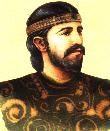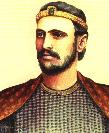

On a November day in 1185 hundreds of Bulgarians amassed in front of the newly erected Church of St. Demetrius in Turnovo. They came to celebrate the church's inauguration, hut cheered even louder at the appearance of two nobles, the brothers Todor and Assen (also known as Belgun). Although the crowd had gathered for a holy purpose, everybody there knew the two nobles had other plans in mind. Someone in the crowd drew a sword and spoke prophetic words: "This is not the time to stay idle; it's time that we took up arms and fought the Byzantines!"
The two nobles' elder brother, Todor, was crowned tsar and took the name of Peter. After 167 years of Byzantine domination, the Bulgarians again had a state of their own. After a century and a half of humiliation, suffering and many suppressed revolts, they proved they were still statehood-conscious and that the memory of Krum and Simeon still lived.
It is no coincidence that the two brothers, with a trace of Kumanian blood in their veins, chose to call a revolt at the time when Byzantium was in a state of decline, weakened by internal conflicts and by Hungarian and Norman assaults. Heavy taxes and political oppression and persecution had stirred up discontent in the Bulgarian lands. When in 1185 another tax was levied on the population north of the Balkan range, the two brothers saw the opportune moment for a new uprising.
In the battles for Bulgaria's liberation, which spanned a whole decade, Peter and Assen demonstrated both strong will and military talent. Their patriotism won them the confidence of the nation and their calls for troops met with an active response throughout the territories north of the Balkan range. First they liberated the northern part of Bulgaria and temporarily withdrew beyond the Danube with their troops. Then, after recapturing their lands and the new capital of Turnovo, Peter and Assen drove the Byzantine army south to Eastern Thrace and fought their way to the Prosek fortress in the Vardar region of Macedonia.
A decisive battle was fought in 1187 near the town of Lovech. After a three-month siege Emperor Isaac II Angelus failed to crush the resistance of the defenders of the fortress, fighting for their newly liberated state. In the end, the basileus was forced into a treaty, but he took the two leaders' younger brother Kaloyan to Constantinople to guarantee good behavior from his neighbor.
The most important gain from the 1187 battles was the recognition of the Bulgarian state. With self-confidence boosted by their triumph, the two brothers appointed an archbishop of the now independent Bulgarian church.
In the hard times when the Second Bulgarian State was regrouping from Byzantine domination, the two brothers joined their efforts for the consolidation of the new dynasty. A man of noble spirit, Peter recognized his younger brother's superior skills as a commander and statesman. Assen was crowned Tsar, and most of the Bulgarian lands came under his control. Peter retained his throne and the lands around the one-time capital Preslav.
In the fight with Byzantium the two brothers took advantage of the alleviation of Byzantine pressure owing to the passage of the Third Crusade through the Balkans, and urged the Kumanians to send their swift cavalry against the Byzantines. Glorious victories were won in the battles in the Tryavna pass and near Arcadiople (Eastern Thrace). The borders of the state extended far south into Thrace and the Aegean region. Even the battle-hardened Hungarians were unable to put up resistance to the army of Assen and Peter, and after a series of Bulgarian-won battles, were forced to give back to Bulgaria the regions of Belgrade and Branichevo.
The Byzantine chronicler Nicetas Choniates wrote that the brothers were striving to unite the three Bulgarian regions: Moesia, Thrace and Macedonia under their rule, as it had been in earlier times. They did not conceal their ambition to restore Bulgaria to its one-time glory. The whole of the rebellious Bulgarian people stood behind them.
The founders of the new dynasty did not die in battle, at the hands of their enemies. Alarmed and annoyed by the resurgence of the Bulgarian state, the Byzantines incited the boyars to plot against the Tsar. In 1196 Tsar Assen I was murdered by his cousin Ivanko. Some 700 years later, during the period of national revival, a writer of the name of Vassil Droumev depicted the story in the first Bulgarian drama: Ivanko, Assen's Murderer. Tsar Peter sent the cousin into exile but before a year had elapsed, himself became the victim of a conspiracy. However, by that time the Bulgarian state was back on its feet again.
Meanwhile, having escaped from Constantinople, younger brother Kaloyan was riding fast towards.

 My name is Radostina Georgieva, "Roddy".
My name is Radostina Georgieva, "Roddy".